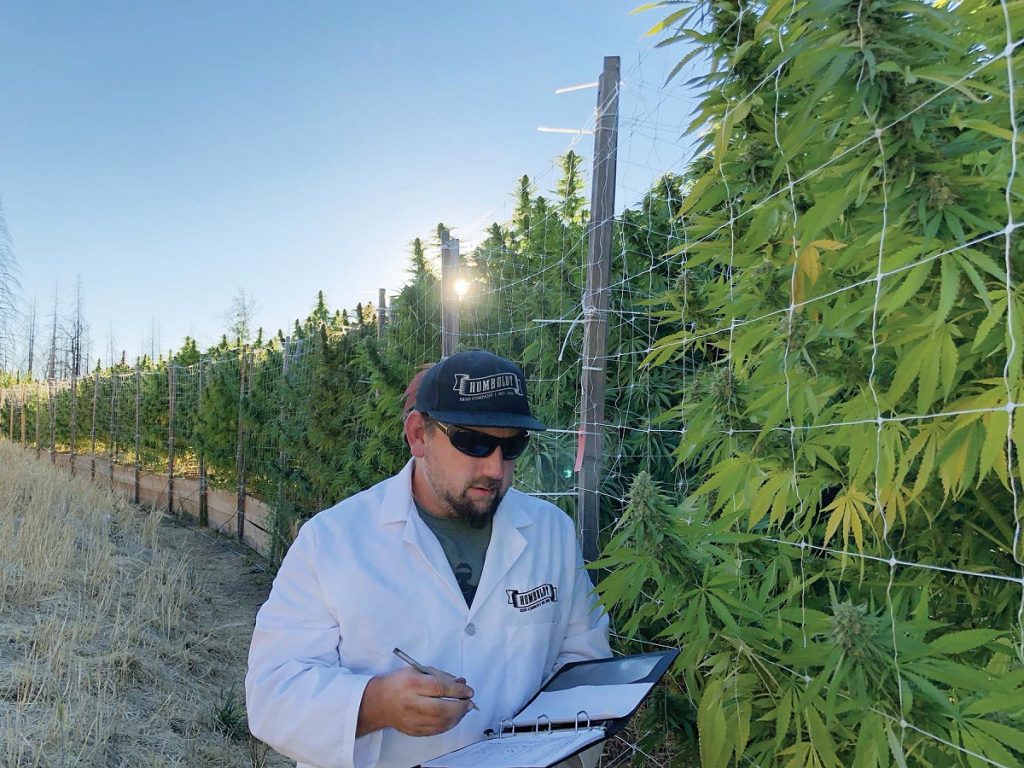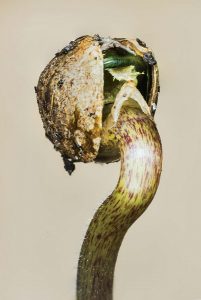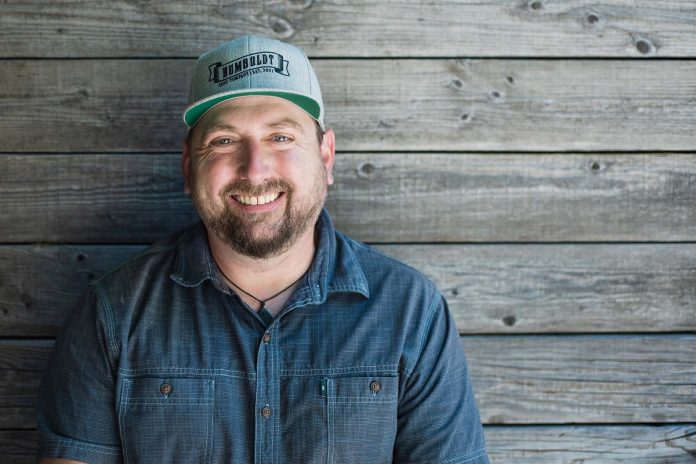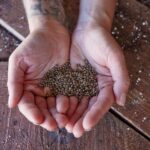Deep in the damp, misty forests of eastern Humboldt County, California, a farm that once was the best-kept secret in the state is a secret no longer.
Humboldt Seed Company began breeding cannabis strains and cloning plants in 1998. Today, the farm operates in multiple U.S. states and two foreign countries.
Founder and Chief Executive Officer Nathaniel Pennington arrived in northern California in 1996, just as the state was preparing to scandalize the nation by defying federal law. “I took a look around and promptly voted yes on medical marijuana,” he said. “And it didn’t take long for me to exercise my rights [to grow cannabis legally].” He soon discovered he had a knack for breeding new varieties. Even though he considered the work a hobby, he quickly became the go-to guy for regional farmers who lusted after his unique clones. Most of the time, he shared them at no charge.
Eventually, “My girlfriend said to me, ‘I’m tired of these farmers showing up in the middle of the freezing night asking for seeds,’” he recalled. “She demanded I begin to ask for money for them.” He applied for a business license the next day.
Flash-forward twenty years: Pennington’s former profession, fisheries biologist, has become his hobby and HSC his life. The business is thriving, with licensed grows in several California locations as well as Oregon and Oklahoma. “We also have operations starting up in Massachusetts, Maine, Canada, and Spain,” he said.

All of them adhere to the principles Pennington established in the beginning: They’re efficient and environmentally friendly. The Humboldt County farm is 100-percent carbon neutral and self-sustaining, with solar and micro-hydroelectric power. “We pride ourselves in finding a perfect balance between forsaking science and forsaking nature,” he said.
Pennington also takes pride in a corporate culture he characterized as lighthearted and familial—literally. His daughter, a college student majoring in botany and business, works at the company’s headquarters in Eureka, California. The Oregon and Oklahoma operations are family farms heavily invested in organic agriculture.
The original farm also is remote, which Pennington said is one key to its success.
“The farm is particularly fit for breeding due to its isolation from other permitted farms—hemp or cannabis,” he said. “This is important, so our genetics won’t become compromised with drifting pollen. We have a particularly supportive community and an in-depth relationship with the local native peoples whose territory we technically co-inhabit. We have always grown and bred cannabis there, but as our techniques shifted towards being 100-percent focused on genetic development and breeding, the farm’s infrastructure has evolved significantly.”
From the outset, Pennington focused on uniformity in his product. Because of the way genes combine during breeding, seed-grown plants are not exact duplicates of their parents. He addressed the challenge by back-crossing, or creating inbred lines. After generations of work and experimentation, HSC’s seed-grown plants are virtually identical to the rest of their family. “We’re now taking that to the next level and creating feminized, true-breeding F1 hybrids that are really as close as you can get to ‘clone seeds,’” he said.
The plants HSC grows from its “clone seeds” are meticulously inspected for exemplary characteristics during an annual field-combing event Pennington calls a pheno-hunt. In 2018, he and his crew sorted through a whopping 10,000 seed-grown plants. In 2019, they searched through 2,500 unique plants for the top 1 percent. The process involves much meticulous field cloning and then tracking the clones from individually labeled field plants to the clone trays. Then, they analyze the field-grown clones and select for desirable traits using a phenotype rating system HSC published in 2017.
“Once we’ve selected the overall winners for traits like THC content, terpenes, pest resistance, growth, and structure, we pull the associated clones and propagate them for licensing and breeding,” Pennington said.
“We believe the combination of real hands-on cannabis experience and the understanding of conventional breeding strategies are critical to creating the cannabis genetics that will not only perform well in the agricultural setting, but also entice today’s picky consumers,” he added. “Cannabis is one of the more phenotypically diverse plants out there, and we can rest assured that humanity will be breeding and working with the species for decades before we feel we have explored its full potential.”
As legalization has sprouted from state to state, demand for HSC’s seeds has increased—monumentally. The company now sells seeds to dispensaries in addition to farmers. Pennington believes as stigma surrounding cannabis dissipates, consumers will be increasingly interested in starting their own backyard grows. “We enjoy working with the backyard grower because they’re really just trying to enjoy the plant,” he said. “But it’s the pressures facing the cannabis farmer that motivate us to improve genetics quickly and efficiently.
“We’ve been managing growth by expanding production and building out additional infrastructure on our existing licenses,” Pennington said. “We’re producing and marketing about fifty times more seeds and genetics than we were in 2016, and our confidence in our product has actually increased due to being completely focused on breeding.”

HSC’s unique spot in the marketplace has resulted in quite a bit of innovation. Fifteen years ago, for example, Pennington devised a specialized greenhouse for growig inbred lines. “Using our inherent sense of Humboldt innovation, we were able to modify our light-deprivation techniques to create small breeding chambers that created both spatial and temporal separation for pollination events,” he said. “This has allowed us to guide strains in clear pathways rather than just simply crossing the latest polyhybrids, which seems to be so prevalent in the industry. We always proof our breeding chambers for any possible cross contamination by leaving one of the fifty-plus mini greenhouses or breeding chambers without a pollinator. Fortunately, the result of that scientific control experiment has always been amazing, smokable, seedless cannabis, and we aren’t afraid to admit we don’t just sample that result in laboratories.”
Pennington said perhaps the most exciting thing he has learned in his twenty-plus years tending to, breeding, and cloning cannabis seeds is the incredibly diverse expressions of terpenes, flavonoids, and cannabinoids when crossbred across distinct populations. In fact, HSC often purposely crosses completely unrelated populations just for phenotype hunting and selection, because that’s where the interesting expressions show up. “We call them unicorns,” he said. “We do all that work so farmers—and even the home gardener—can have new strains that bring new effects. That keeps cannabis interesting for the consumer, and we can continue to explore the vast medicinal potential of this amazing plant.”
HSC’s 3 Keys to Success
1. Select a focus and stick to it.
Pennington decided he wanted to breed cannabis and create commercial seeds. While he admits being tempted to do other things and enter other markets that might be more profitable, he has stuck to the area that leverages his experience and expertise.
2. Follow your instincts.
While most of the cannabis community was throwing away exotic cannabis genetics in favor of monoculture OG clones, HSC held onto genetics like Blueberry Muffin, which Pennington expects will become a classic. As cannabis has come into the light, he said, so have its unique exotic flavors.
3. Rely on science and experience.
Many other farmers rely solely on science, but HSC balances environmental, holistic, and experiential methods with cutting-edge science. Pennington used genomics to get salmon on the Endangered Species List and now uses the same principles to select cannabis varietals.










